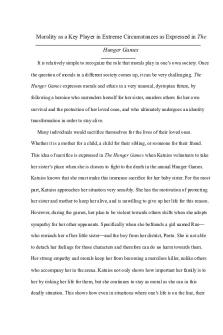The sura as a unity: A twentieth-century develolpment in Qur'anic exegesis PDF

| Title | The sura as a unity: A twentieth-century develolpment in Qur'anic exegesis |
|---|---|
| Author | Mustansir Mir |
| Pages | 8 |
| File Size | 1.5 MB |
| File Type | |
| Total Downloads | 489 |
| Total Views | 850 |
Summary
8 The sura as a unity *"•£?£ a^y^SJSTS^:'- a"d Sh3"ef- AMUl KadeI A" A twentieth century development in Qur'an exegesis Mustansir Mir Twentieth-century Qur'an commentary makes a definite break with the traditional style of exegesis, which, in general terms, may be sai...
Description
8 The sura as a unity *"•£?£ a^y^SJSTS^:'- a"d Sh3"ef- AMUl KadeI A" A twentieth century development in Qur'an exegesis Mustansir Mir
Twentieth-century Qur'an commentary makes a definite break with the traditional style of exegesis, which, in general terms, may be said to have lasted from the early Islamic centuries to the end of the nineteenth century.1 One manifestation of this break is the view that the quranic suras are unities. I shall argue that this view is now fairly well-established in modern Qur'an commentary. I shall do so by looking at the works of a number of modern exegetes. The study is divided into four sections. The first section provides a brief historical background. The second section gives a descriptive account of the relevant aspects of the works of six modern Qur'an commentators. The third section of fers an analysis of that account. A few general remarks make up the fourth, concluding section. PRELIMINARY In itself, the idea of the suras as unities is not new. Zarkashi (745-794/1344-1391) in his Burhdn1 devotes a whole chapter to it, and so does Suyuti (d. 911/1505) in his Itqan,3 an abridgment and revision of Zarkashl's work.4 Zarkash! reports the disagreement of scholars on the subject 'Izz al-Din ibn 'Abd al-Salam (577-660/1181-1262) argues that the Qur'an, revealed as it was under extremely diverse circumstances and in a period of more than twenty years, could not possibly have continuity and coherence (irtibdt). One of Zarkashi's mashayikh, identified by Suyuti as Wall al-Din al-Mallawi,5 rebuts the argument by saying that while historical circumstances determined the order in which the quranic revelations were sent down, considerations of wisdom determined the order in which those revelations were arranged: wa-faslu'l-khitdbi annahu 'aid hasabi 'l-waqa'i'i tanzilan wa-'ala hasabi 'l-hikmatitartOtan." Zarkashi himself speaks of what he calls 'Urn al-mundsaba in quite favorable terms, identifying a few types of mundsabdt one may find in...
Similar Free PDFs

The Teacher as a Curricularist
- 1 Pages

Satan as a Hero in Paradise Lost
- 4 Pages

A Portrait of the Artist as a Young Man
- 317 Pages

education as a institution
- 34 Pages

Sexuality as a Construction
- 1 Pages

Subaru as a brand - Grade: A
- 2 Pages

The Rats In The Walls - Grade: A
- 3 Pages

Lab - As Dense as a Penny
- 7 Pages

Unity AND Diversity in India
- 13 Pages
Popular Institutions
- Tinajero National High School - Annex
- Politeknik Caltex Riau
- Yokohama City University
- SGT University
- University of Al-Qadisiyah
- Divine Word College of Vigan
- Techniek College Rotterdam
- Universidade de Santiago
- Universiti Teknologi MARA Cawangan Johor Kampus Pasir Gudang
- Poltekkes Kemenkes Yogyakarta
- Baguio City National High School
- Colegio san marcos
- preparatoria uno
- Centro de Bachillerato Tecnológico Industrial y de Servicios No. 107
- Dalian Maritime University
- Quang Trung Secondary School
- Colegio Tecnológico en Informática
- Corporación Regional de Educación Superior
- Grupo CEDVA
- Dar Al Uloom University
- Centro de Estudios Preuniversitarios de la Universidad Nacional de Ingeniería
- 上智大学
- Aakash International School, Nuna Majara
- San Felipe Neri Catholic School
- Kang Chiao International School - New Taipei City
- Misamis Occidental National High School
- Institución Educativa Escuela Normal Juan Ladrilleros
- Kolehiyo ng Pantukan
- Batanes State College
- Instituto Continental
- Sekolah Menengah Kejuruan Kesehatan Kaltara (Tarakan)
- Colegio de La Inmaculada Concepcion - Cebu






